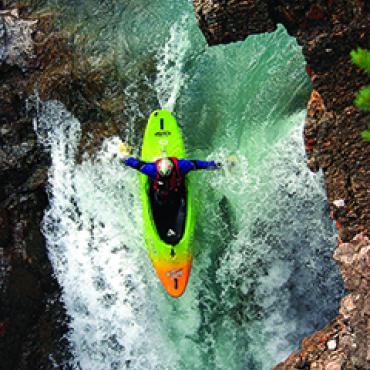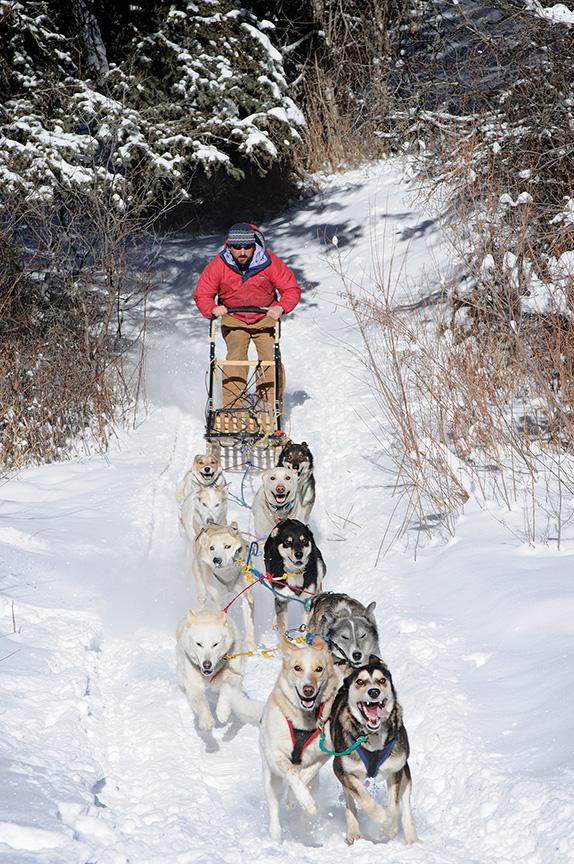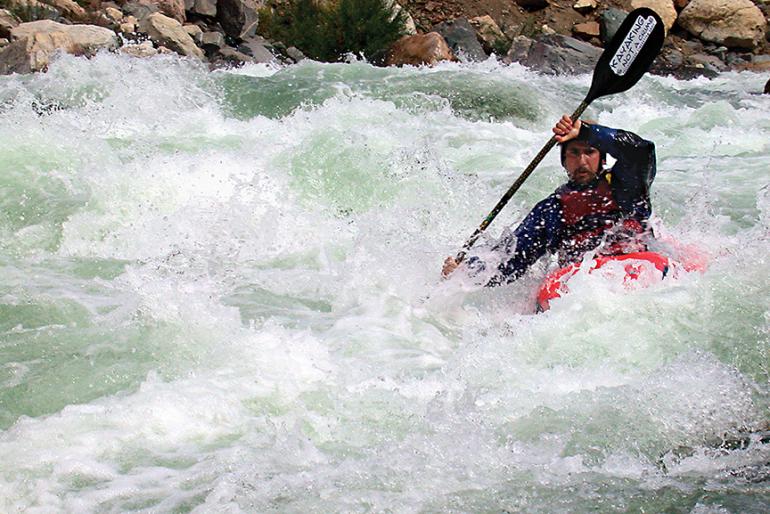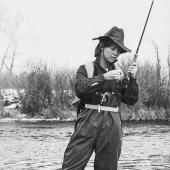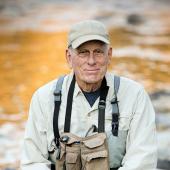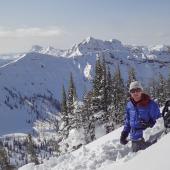Mountain Man
Q&A with Jason Matthews.
Jason Matthews drifted into the northern Rockies in 1993 like a modern-era Huck Finn. Like many of us, the path of this young vagabond was stoked by something not easily defined and nearly impossible to corral. One thing, however, was for certain. His quest for the intangible glory of a mountain life was to take root in Montana.
Matthews is many things: Class V kayaker, musher, father, bear expert, wildlife photographer, television personality, bartender, raft guide, Kardashian provocateur, tipi dweller, Deadhead, businessman… the list goes on. He has presided over rowdy whitewater festivals, been stalked by polar bears, and created opportunity after opportunity in an outdoor industry not always known for inclusivity. For those fortunate enough to have spent time around the campfire with him, there are no surprises to be found here. Just memories of belly-aching laughter alongside this impressive force of, and for, nature. I had an opportunity to join Jason for a day of dogsledding and catching up in Cooke City recently.
Dave Schroeder: You had a pull toward the “West” from early on in your life and I think that strikes a common chord with many people. What is your take on this innate drive in some individuals to chase the sun into the wild country?
Jason Matthews: Well, our story, meaning yours and mine, the pilgrims, the gold rush, Chris McCandless… they are all quite similar, really. A wanderlust. The promise of the West. Not necessarily a promise of fame and fortune, but of adventure, of a new life, a new beginning, with the opportunity to define yourself as an individual. Leaving behind the comforts and conformity of home, this idea of “the West”—be it Alaska or Montana or wherever—all of these wild places and our stories are just the latest telling of the same rite of passage.
DS: River Source Outfitters, the kayak/raft company you founded on the Yellowstone River, has always been a good thing for you, but it did not satiate your appetite for adventure-based business. Are you enjoying the expansion to other outdoor pursuits?
JM: Absolutely. My main passions in life have been, and still are, based around wilderness. Be it wildlife viewing, river travel, dogsledding… I have just slowly expanded from the base that is River Source Outfitters. These days, I’m less about sharing just river experiences with people and more about sharing wilderness adventure travel and wildlife-viewing opportunities, particularly with bears and wolves.
DS: Things really accelerated quickly for you when you decided to expand. You now have great gigs with Wild Alaska Travel in ANWR / Gates of the Arctic, various ventures with NatGeo, have appeared on numerous outdoor TV shows, and built a successful dogsledding operation right here at home. Is there a favorite thing that you do?
JM:What’s important to me now is simply sharing my love for the outdoors with people that don’t necessarily spend much time in the wild. To be in remote areas and share what is often a really meaningful experience, something that may change someone’s outlook or perspective on life, that’s what my mission is now.
DS: How did you make the connections that have allowed you to construct your current guiding opportunities?
JM: Just spending a lot of time in wild places, having diverse skill sets, and running into the right people and having them realize I was willing to stay outside in really remote places for days, weeks, or months on end. It's at the point now, I don't really go looking for opportunities. People just contact me and ask if I would like to join their expedition or guide for them. It has been 20 years in the making though. I feel fortunate that people are willing to pay me to do what I want to be doing anyway. Exploring wild places on foot, by vehicle, dog team, or river with a camera in my hand and a group of like-minded travelers.
DS: You are off to Tibet… Sounds interesting, please explain what you are up to over there.
JM: Working with an organization called the Tibet Eco-Travel Collective. We are training Tibetan trekking guides in Wilderness First Aid, Leave No Trace practices, and group-client management. It's an on-going project to raise the standards of guides in the developing Tibetan eco-travel industry.
DS: What got you interested in expanding into a dog sledding operation?
JM: The love of winter and sled dogs. I became interested in dog-sledding in 1995 when I got a Malamute named Luna from an animal shelter in Kalispell. She, a few friends and I lived in a small off-the-grid cabin with no running water that we built in the mountains outside of Bigfork, Montana. We lived about a mile off the road, and had to ski or walk in and out of the cabin to where we parked our vehicles. I started experimenting with hooking her up to haul gear on a kids sled, then pulling me on skis. From there, things have just grown out of control I guess!
DS: How do you keep up with 72 dogs 365 days a year?
JM: In the winter we have nine employees that do the majority of the work. In the spring, it's usually just me feeding, watering, and picking up poop. In the summer and fall while I'm in Alaska guiding, it's my amazing wife Catherine who often does the chores with our two young sons in tow. I also have a few volunteers (Dan, Ansel, Hillary) that help out a lot, for the love of sled dogs. Our numbers of dogs also goes down in the summer, as I take about half of the dogs to Alaska to work on a glacier / helicopter operation outside of Juneau.
DS: Where do you offer dogsledding trips in our area?
JM: Near Big Sky and West Yellowstone. Up in the Taylor Fork area, and on Lone Mountain Ranch in Big Sky.
DS: Do you enjoy dogsled racing?
JM: Yes, I love sled-dog racing. It's the only sport I follow. The Iditarod is a great event to track and watch online. I have raced a fair amount in the past. But, it is really just an expensive hobby. So, I don't race much these days. We prefer to share our dogs with tourists and show them our beautiful mountainous regions, and make a living in the process.
DS: Do you consider Yellowstone to be a true wilderness area?
JM: Wow, that is a loaded question that can incite riots! I guess the question can be answered a few ways though, depending on how you define wilderness. If you go by the Federal designation of "Wilderness" than no, it is not a wilderness. But, if you want to think in other terms, then it is open for discussion. My gut feeling is no, I don't find it a true wilderness. I view it as an island-like region, that we have isolated from the rest of the ecosystem, by not allowing the natural seasonal migration of the wildlife, from the high mountains, into the prairie/grasslands to happen.
The whole situation with wildlife management is horrible. Yellowstone is basically just a very large captive animal setting in my opinion. When an elk, bison, or wolf strays from the Park it is either killed, hazed, or entrapped and quarantined. If a bear steps out of line and does something we humans don't like it is "removed from the population." The wildlife is held captive because they cannot leave the Park when the snow deepens, and follow their natural migratory routes without be negatively managed. So, the way it is now, I find it too small a chunk of land to be a real tract of wilderness (by my terms). The animals just can't lead a fully natural, wild existence there.
Plus, it is being loved to death, it is overrun with people. In the summer, it is more like a zoo than a wilderness. The long lines and traffic jams. The masses of people crowding habituated animals just to get the exact same picture as everyone else—it's sad really. I think the original draw for people to Yellowstone is the lure of the the untrammeled west, the ideal of wilderness, and the promise that there is still a place that mankind is not king. At first glance, to the uninformed, that appears to be the reality. But, the more time I spent in Yellowstone, and the more I studied the situation that animals face due to politics and management, the more I realized that ideal to be false.
I think the experience people plan and dream to have in Yellowstone just is often not delivered anymore. The romance of communing with nature in a primordial landscape untouched by man is tough to deliver in a traffic jam, or in a line of people waiting to see a geyser go off, or a bear ramble down the road. It does still happen. People are still having life-expanding experiences there, but I think those people are really working for them, seeking them. The casual visitor is missing a lot though.
However, I do think Yellowstone is still very important to our culture, our wildlife, and our psyche even if it's not a wilderness. Although the animals are heavily managed and involuntarily contained, at least they are there, living and easily viewed. Also, for the person willing to go deeper, away from the roads and parking lots there is still a lot of wild country to explore and adventures to be had. So, in that light, I find Yellowstone to be a real stepping stone to wilder places, a place that can fuel the imagination for wild country and educate us about wildlife, and make us aware of the importance of large tracts of wildlands to wildlife populations.
DS: You spend time each year in ANWR (Arctic National Wildlife Refuge, Alaska) these days. Can you explain what you are doing up there?
JM: I've been really lucky. For the past several years, I have spent my falls working in the Arctic National Wildlife Refuge on various Polar Bear-related projects. I first went there working on a National Geographic-funded project, hoping to document a hybrid polar-grizzly bear. While there, I made some contacts, and have now gone back five times. I went back once and worked with a British natural history film producer for a BBC production. The other times I have gone back as a guide for polar bear-viewing / photography trips. At this point, I have created a huge catalog of polar bear images and footage that I hope to do something with, when I eventually get some spare time.
DS: Can you describe what you are witnessing regarding the situation of the polar bears in that area?
JM: I find the catalog of photos and footage I've acquired important, because of the developing situation with the particular polar bear population I have been documenting. There are 19 distinct polar bear populations around the arctic. The Southern Beaufort Sea population lives in ANWR, and scientists have recorded a 40% decline in that population since 2000. So, what I started documenting without even realizing it, is perhaps an important moment in natural history—the extinction of an iconic species. Not sure if that will really be the case, but it could be. I hope not, but I intend to keep returning there regularly to watch, learn, and document.
DS: Knowing you as I do, I cannot imagine you are satisfied as of yet. What is on the horizon for you?
JM: Since the start of my career, I've always been motivated by one thing—providing opportunities and experiences to people to interact with the natural world. I live to get other people out to wild places, all in hopes that they will be moved by those experiences so much, that they in some way will act to make the world a better place—take a stand for conservation, and be good stewards of the land. My goal now is to pass that ethic and passion on to my two sons, Noah and Silas. I want to continue to share the world with them, and hopefully be able to integrate them and their mom more into my travels. So raising wild kids—that's my newest gig!
Find out more about Jason Matthews at yellowstonedogsledadventures.com.


